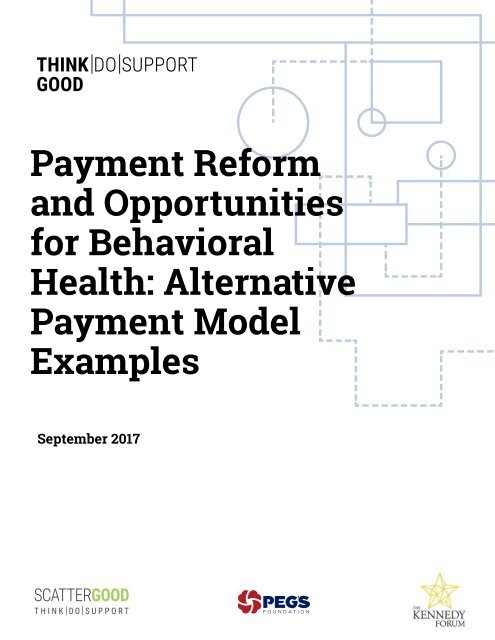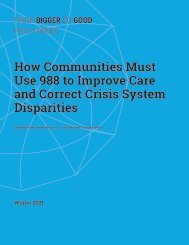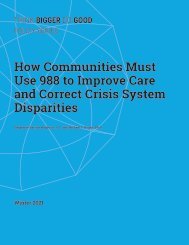Alternative Payment Models
Create successful ePaper yourself
Turn your PDF publications into a flip-book with our unique Google optimized e-Paper software.
<strong>Payment</strong> Reform<br />
and Opportunities<br />
for Behavioral<br />
Health: <strong>Alternative</strong><br />
<strong>Payment</strong> Model<br />
Examples<br />
September 2017<br />
1
Dear Reader,<br />
<strong>Payment</strong> reform is at the center of discussions concerning health care reform. It is one recommended<br />
approach to address the dual problems of climbing U.S. health care costs and poor patient outcomes.<br />
Reformers propose switching from volume-based payment systems to value-oriented, alternative<br />
payment models to improve care quality and reduce costs. Unfortunately, alternative payment reform<br />
proposals rarely have considered behavioral health care.<br />
<strong>Alternative</strong> payment arrangements can contribute to the expansion of many evidence-based behavioral<br />
health treatments, such as medication-assisted treatment of addiction, collaborative care, tele-mental<br />
health, and early intervention to promote recovery after an initial psychotic episode. These payment<br />
models may be diverse in their financing structures and cover a range of interventions, yet they should<br />
share four core values: measurement-based care, clinically appropriate technology for monitoring,<br />
value-based payments, and flexibility in care delivery.<br />
As funders, the Thomas Scattergood Behavioral Health Foundation and Peg’s Foundation initiated a<br />
project to collect and further develop behavioral health alternative payment models. The project drew<br />
upon the experience of collaborators in academic institutions, advocacy organizations, medical and<br />
behavioral providers and payers. This preliminary report introduces alternative payment models under<br />
development. To be released in fall 2017, the final report will include detailed descriptions of models<br />
adaptable by both public and private payers.<br />
All treatments included in the report have a substantial clinical evidence base supporting their ability<br />
to improve patient outcomes and reduce costs. The report focuses on innovative funding structures and<br />
how they might increase the widespread dissemination of proven therapies.<br />
Through these tangible solutions, we believe that collectively we will begin to improve quality and<br />
reduce the cost of U.S. health care.<br />
Sincerely,<br />
Joseph Pyle, M.A.<br />
President<br />
Thomas Scattergood Behavioral<br />
Health Foundation<br />
Rick Kellar, M.B.A.<br />
President<br />
Peg’s Foundation<br />
<strong>Payment</strong> Reform and Opportunities for Behavioral Health: <strong>Alternative</strong> <strong>Payment</strong> Model Examples 2
<strong>Payment</strong> Reform<br />
and Opportunities<br />
for Behavioral<br />
Health: <strong>Alternative</strong><br />
<strong>Payment</strong> Model<br />
Examples<br />
Amanda Mauri, M.P.H.<br />
Henry Harbin, M.D.<br />
Jürgen Unützer, M.D., M.P.H., M.A.<br />
Andrew Carlo, M.D.<br />
Robert Ferguson, M.P.H.<br />
Michael Schoenbaum, Ph.D.<br />
September 2017
We would like to acknowledge and thank the following individuals<br />
for their contributions to this paper.<br />
Alan Axelson, M.D.<br />
IntercareHeatlh<br />
Gary Capistrant, M.A.<br />
American Telemedicine Association<br />
Reza H. Ghomi, M.D., M.S.E.<br />
University of Washington<br />
NeuroLex Laboratories<br />
King County Behavioral<br />
Health Advisory Board<br />
Gary Mendell, M.B.A.<br />
Shatterproof<br />
Sam Muszynski, J.D.<br />
American Psychiatric Association<br />
Andrew Carlo, M.D.<br />
University of Washington<br />
Eileen Carlson, R.N., J.D.<br />
American Psychiatric Association<br />
Debbie I. Chang, M.P.H.<br />
Nemours Children’s Health System<br />
Nathaniel Counts, J.D.<br />
Mental Health America<br />
Alyson Ferguson, M.P.H.<br />
The Thomas Scattergood Behavioral<br />
Health Foundation<br />
Robert Ferguson, M.P.H.<br />
Jewish Healthcare Foundation<br />
Howard Goldman, M.D., Ph.D.<br />
University of Maryland School of Medicine<br />
Daniella Gratalle, M.A.<br />
Nemours Children’s Health System<br />
Darcy Gruttadero, J.D.<br />
National Alliance on Mental Illness<br />
Henry Harbin, M.D.<br />
Health Care Consultant<br />
Former CEO of Magellan Health Services<br />
Rick Kellar, M.B.A.<br />
Peg’s Foundation<br />
Angela Kimball<br />
National Alliance on Mental Illness<br />
Joe Pyle, M.A.<br />
The Thomas Scattergood Behavioral<br />
Health Foundation<br />
Shawn Ryan, M.D., M.B.A., A.B.E.M.,<br />
F.A.S.A.M.<br />
American Society of Addiction Medicine<br />
Payer Relations Committee<br />
Michael Schoenbaum, Ph.D.<br />
National Institute of Mental Health<br />
Robyn Tanis<br />
Pinnacle Treatment Centers<br />
Latoya S. Thomas<br />
American Telemedicine Association<br />
Jürgen Unützer, M.D., M.P.H., M.A.<br />
University of Washington<br />
Amanda Mauri, M.P.H.<br />
University of Michigan<br />
Note: To complete this report, the Thomas Scattergood Behavioral Health Foundation and Peg’s Foundation contacted several organizations and<br />
individuals to discuss payment reform. This list is not exhaustive of all individuals contacted. In addition, contributor participation does not<br />
mean a formal endorsement of the content within this report.<br />
<strong>Payment</strong> Reform and Opportunities for Behavioral Health: <strong>Alternative</strong> <strong>Payment</strong> Model Examples 4
Authors<br />
Amanda Mauri, M.P.H.<br />
Ph.D. Student in Health Services<br />
Organization & Policy<br />
University of Michigan<br />
amauri@scattergoodfoundation.org<br />
Jürgen Unützer, M.D., M.P.H., M.A.<br />
Professor and Chair<br />
Psychiatry and Behavioral Sciences<br />
University of Washington<br />
unutzer@uw.edu<br />
Robert Ferguson, M.P.H.<br />
Director of Government Grants and<br />
Policy<br />
Jewish Healthcare Foundation<br />
ferguson@jhf.org<br />
Henry Harbin, M.D.<br />
Health Care Consultant<br />
Former CEO of Magellan Health Services<br />
htharbin@aol.com<br />
Andrew Carlo, M.D.<br />
Senior Research Fellow<br />
University of Washington<br />
adc42@uw.edu<br />
Michael Schoenbaum, Ph.D.*<br />
Senior Advisor for Mental Health<br />
Services, Epidemiology, and Economics<br />
Division of Services and Intervention<br />
Research<br />
National Institute of Mental Health.<br />
schoenbaumm@mail.nih.gov<br />
In developing this paper, we have been pleased to work with the following organizations: AIMS Center, American Society of<br />
Addiction Medicine, American Telemedicine Association, Jewish Healthcare Foundation, Mental Health America, National<br />
Alliance on Mental Illness, Nemours Health System, and Pinnacle Treatment Centers. As we move forward with the project,<br />
we are interested in receiving comments on payment reform and additional recommendations.<br />
Please e-mail paymentreform@scattergoodfoundation.org with your comments.<br />
*The views expressed in this work are those of the authors, and not necessarily of the National Institute of Mental Health,<br />
the National Institute of Health, or the federal government<br />
<strong>Payment</strong> Reform and Opportunities for Behavioral Health: <strong>Alternative</strong> <strong>Payment</strong> Model Examples 5
The U.S. healthcare system is undergoing immense transformation as public and<br />
private payers test and implement strategies to improve care quality and patient<br />
outcomes and reduce costs. This movement could not come at a more appropriate<br />
time, as U.S. healthcare expenditures approach three trillion dollars annually,<br />
accounting for nearly 18% of gross domestic product. 1 Several factors contribute<br />
to the rising cost of healthcare. These include, but are not limited to, the aging<br />
population, changing disease prevalence, inadequate investment in social services,<br />
and emphasis on expensive medical interventions. 2 Furthermore, the general<br />
difficulties associated with measuring health care outcomes limit the influence of<br />
natural market forces that typically drive purchasing behaviors and competition.<br />
Another driver of elevated health care spending in the U.S. is clinician fees, which<br />
are substantially higher than those in peer nations. 3 Throughout the modern history<br />
of this country, health care payment has largely consisted of various fee-for-service<br />
(FFS) arrangements in which clinicians submit billing codes for each unit of service<br />
delivered and receive retrospective payments. While FFS has the potential to<br />
incentivize work productivity and efficiency, it also inherently compels clinicians<br />
to focus on volume instead of outcomes. 4 Unfortunately, when providers attempt to<br />
redesign care delivery to provide higher-quality services, they often face the barriers<br />
of inadequate payment for services not traditionally covered by payers or financial<br />
penalties for performing fewer or lower-cost services.<br />
<strong>Payment</strong> reform provides an opportunity to address the rising cost of U.S.<br />
healthcare. Shifting from volume-driven systems to value-oriented alternative<br />
payment models (APMs) can improve care quality and reduce cost. APMs<br />
align reimbursement with cost-efficient, high-quality care by increasing<br />
provider flexibility and incorporating measurement-based payment. Examples<br />
of APMs include accountable care organizations (ACOs), bundled payments,<br />
and provider capitation.<br />
Despite the copious discussions on health care payment reform in recent years,<br />
there has been little focus on behavioral health. 5, 6, 7 A recent survey of 257 ACOs<br />
found that “most ACOs have done little to move beyond the traditional model of<br />
fragmented primary and behavioral health care.” More than one-third of these ACOs<br />
did not maintain relationships with behavioral health provider groups, and only 14%<br />
fully integrated primary and behavioral healthcare. 8 Another recent survey found<br />
that ACOs commonly excluded substance use providers, with only 15% of surveyed<br />
specialty organizations reporting a formal agreement with an ACO. 9<br />
<strong>Payment</strong> Reform and Opportunities for Behavioral Health: <strong>Alternative</strong> <strong>Payment</strong> Model Examples 6
Behavioral health is also often absent from the standardized<br />
and quantifiable screening and outcomes measures that<br />
are essential to payment reform and measurement-based<br />
care. Many Medicaid and commercial ACOs do not require<br />
depression screening, United States Preventive Services<br />
Task Force (USPTF)-recommended services, or non-process<br />
outcomes reporting. Furthermore, the only non-process<br />
measures related to behavioral health within the Centers for<br />
Medicare and Medicaid Services (CMS) Core Quality Measure<br />
Collaborative (CQMC) measure set governing Medicare ACOs<br />
focus on depression screening and remission. 10 While the 2017<br />
Medicare Shared Savings Program and Next Generation ACO<br />
Model’s performance measures include metrics related to the<br />
general patient/caregiver experience (i.e., shared decision<br />
making, provider communication and physician ratings),<br />
these are not specifically focused on mental health outcomes.<br />
There are two metrics focused on depression screening<br />
and remission, but effective measurement-based practice<br />
should cover a fuller range of outcomes for mental health and<br />
substance use disorders and services. 11, 12, 13 The overall lack<br />
of representation of behavioral health metrics in Medicare<br />
ACOs is particularly unfortunate given the significant number<br />
of validated measurement-based care instruments, such as<br />
Patient Health Questionnaire-9 (PHQ-9), Generalized Anxiety<br />
Disorder-7 (GAD-7), and Altman Scale, that are ready for<br />
immediate adoption.<br />
Behavioral health’s virtual absence from APMs is also<br />
concerning given the substantial financial costs associated<br />
with mental illness and addiction. Whether present as the<br />
primary diagnosis or as a comorbid condition to physical<br />
illness, behavioral health disorders are a principle driver of<br />
overall health care costs. The reasons for this are multifold and<br />
range from the propensities of mental illness and substance<br />
use disorders to cause significant functional impairment to<br />
the noteworthy prevalence of these conditions in the U.S.<br />
population, which has been estimated to be as high as twentysix<br />
percent. 14, 15 Furthermore, behavioral health conditions<br />
are associated with premature mortality and higher overall<br />
utilization of health services, including those for primarily<br />
physical illness. 16, 17 For instance, the per member per month<br />
costs for management of patients with arthritis, asthma,<br />
diabetes, and hypertension increase when the patient has a<br />
co-morbid behavioral health condition. 18, 19 A report completed<br />
by Milliman using data from Medicare, Medicaid, and<br />
commercial insurance found that the total cost of care for<br />
patients with comorbid behavioral health conditions was 2.5<br />
20, 21<br />
to 3.5 times that of their peers with only physical illness.<br />
Given the expected increase in older adults with mental illness<br />
from under eight million in 2010 to fifteen million in 2030, the<br />
economic impact of behavioral health conditions appears to be<br />
trending upward. 22<br />
As noted earlier, alternative payment structures in the U.S.<br />
have rarely focused on behavioral health, leaving most of<br />
this care reimbursed in FFS models. 23 To be most effective,<br />
payment reform should incentivize the incorporation of<br />
evidence-based behavioral health treatments into health<br />
systems. It is noteworthy than the U.S. health care system<br />
will continue to utilize FFS, even as APMs are increasingly<br />
designed and implemented. Indeed, many APMs are<br />
deliberately organized to supplement or complement FFS.<br />
Several evidence-based services, such as tele-mental health;<br />
medication assisted treatment; coordinated specialty<br />
care programs for first episode psychosis; Screening,<br />
Brief Intervention, and Referral to Treatment (SBIRT); and<br />
collaborative care, have established FFS reimbursement<br />
mechanisms that remain underutilized by all payers. All<br />
payer use of existing FFS codes would substantially improve<br />
patient and financial outcomes with these services. This<br />
paper recommends a number of approaches to expand the<br />
use of APMs both to supplement existing FFS codes and as<br />
standalone reimbursement models.<br />
<strong>Payment</strong> Reform and Opportunities for Behavioral Health: <strong>Alternative</strong> <strong>Payment</strong> Model Examples 7
While the expansion or full implementation of established FFS codes for evidencebased<br />
services should be a priority, payment reform will increase the use of many<br />
effective interventions and, ultimately, decrease costs. Given the variation in health<br />
care delivery across the country, APM recommendations should be diverse in their<br />
payment structure and cover a range of topics, but share the following core values:<br />
Core Values of All <strong>Alternative</strong> <strong>Payment</strong> <strong>Models</strong><br />
1 Measurement Based Care<br />
2 Technology for Monitoring, Improvement,<br />
and Coordination<br />
3 Value Based <strong>Payment</strong><br />
4 Flexibility in Care Delivery<br />
• Measurement-based care (MBC): MBC is the process of systematically measuring<br />
symptom severity and modifying treatment dependent based on patient outcomes.<br />
Numerous randomized controlled trials confirm the value of MBC for patient<br />
outcomes, including a meta-analysis of six studies that demonstrated that MBC<br />
substantially improved patient outcomes compared with usual care. 24 The efficacy of<br />
25, 26<br />
MBC for patients with behavioral health disorders is also well established.<br />
• Technology for symptom monitoring, care improvement, and treatment<br />
coordination that is clinically appropriate for MBC: Technology is capable of<br />
supporting clinical decision making, empowering consumers, and promoting<br />
innovation. It is particularly useful in APMs, because MBC and value-based<br />
payment arrangements require continuous tracking and improvement of patient<br />
outcomes. Furthermore, many alternative payment arrangements, including ACOs,<br />
accountable health communities, 27 and collaborative care relationships, rely on care<br />
coordination between all providers interacting with the patient. Electronic medical<br />
records support data sharing and should be considered when implementing an APM.<br />
Limitations to technology implementation, including expense, provider productivity,<br />
and privacy, must be weighed against the potential benefits.<br />
<strong>Payment</strong> Reform and Opportunities for Behavioral Health: <strong>Alternative</strong> <strong>Payment</strong> Model Examples 8
• Value-based payments (VBP): VBP arrangements reward providers with incentive<br />
payments for delivering high-quality and cost-effective care. Generally, providers<br />
report on a predetermined set of core and optional measures and receive additional<br />
payments on top of care reimbursement for meeting quality and cost goals. For<br />
example, shared savings—most commonly associated with ACOs—is a type of VBP<br />
arrangement that offers clinicians working together a percentage of any healthcare<br />
savings resulting from their efforts. Common metrics used for VBP include initiation<br />
and engagement in substance use treatment, depression screening, depression<br />
remission, and utilization of emergency department and inpatient hospital services.<br />
Although these common measures employed by both public and private payers cover<br />
a fairly narrow segment of the care spectrum, metrics used within a VBP arrangement<br />
should reflect the target population and capabilities of the provider system.<br />
• Flexibility in care delivery: FFS incentivizes clinicians to deliver a high volume of<br />
services while limiting flexibility in care options to services with billing codes. FFS<br />
also traditionally excludes coverage of critical behavioral health services. APMs,<br />
such as global payment, capitation, and bundled payment, predetermine a fixed<br />
amount of money per time period, patient, or health episode, respectively, offering<br />
providers flexibility in determining the appropriate services. Research has shown<br />
that bundled payment arrangements are cost saving. 28 However, because of FFS<br />
underpinnings, these arrangements may fail to incorporate behavioral healthcare<br />
within a bundle for a common comorbid condition. Capitated payments, which<br />
have been a part of the healthcare landscape since the 1990s, are also not without<br />
limitations. Practices and health systems have found themselves unable to manage<br />
the risk associated with capitation because of inadequate risk adjustment and<br />
resource intensity. 29, 30 In developing APMs for behavioral health, the strengths and<br />
limitations of all models should be weighed against provider flexibility.
Using these core values, the Thomas Scattergood Behavioral Health<br />
Foundation and Peg’s Foundation, with contributions from academic<br />
institutions, advocacy organizations, health systems, foundations,<br />
payers, and providers, has compiled information about several APMs<br />
for behavioral health interventions known to improve patient outcomes<br />
and reduce costs. Most of these services are being reimbursed in part by<br />
all payers via traditional FFS codes, and some are reimbursed via APMs.<br />
This paper aims to assist all payers, including CMS, commercial insurers,<br />
and ACOs, expand evidence-based services, and enhance monitoring of<br />
patient outcomes.<br />
<strong>Payment</strong> reform is needed to improve service delivery in all treatment<br />
settings. Evidence demonstrates the importance of behavioral health<br />
interventions across the treatment spectrum. The benefits of early<br />
intervention and prevention in the treatment of behavioral health<br />
conditions for children and adults are well established. Patients with<br />
behavioral health problems more commonly present in the primary<br />
care setting. 31, 32 Following disease onset, specific behavioral health<br />
interventions are extremely powerful in improving patient outcomes<br />
and reducing associated costs. The models presented aim to increase<br />
access to evidence-based services delivered in all treatment settings,<br />
including early intervention and prevention, primary care, and specialty<br />
care. All models would likely improve patient outcomes significantly<br />
if implemented. The examples are organized by their readiness for<br />
immediate adoption.<br />
11 <strong>Alternative</strong> <strong>Payment</strong> <strong>Models</strong><br />
Currently Under Development<br />
Case Rate for Substance Use Disorders / Specialized Case Rate<br />
for Serious Mental Illness / Value-Based Collaborative Care /<br />
Multi-Payer Collaborative Care / Patient-Centered Opioid<br />
Addiction Treatment <strong>Payment</strong> (P-COAT) / Coordinated Specialty<br />
Care for First-Episode Psychosis / Telehealth / Transitional<br />
Care Bundled <strong>Payment</strong>s / CPC+ Behavioral Health-Add On /<br />
Accountable Communities for Health for Children and Families /<br />
ACO at Risk for Behavioral Health Care<br />
<strong>Payment</strong> Reform and Opportunities for Behavioral Health: <strong>Alternative</strong> <strong>Payment</strong> Model Examples 10
<strong>Alternative</strong><br />
<strong>Payment</strong> <strong>Models</strong><br />
Case Rate for<br />
Substance<br />
Use Disorders<br />
Pinnacle Treatment Centers has a<br />
case rate agreement with a large<br />
insurance company in New Jersey.<br />
Case rates are used to pay for each level<br />
of care (detoxification, rehabilitation,<br />
partial hospitalization, and intensive<br />
outpatient). For case rate eligibility, the<br />
initial admission must be authorized<br />
and the standard criteria (American<br />
Society of Addiction Medicine or<br />
insurer-determined medical necessity<br />
criteria) must be met. Once the<br />
admission is pre-certified, concurrent<br />
reviews to obtain additional days at<br />
the level of care upon admission and<br />
authorizations for additional levels of<br />
care are eliminated. Pinnacle Treatment<br />
Centers needs only to advise the insurer<br />
when the patient has been stepped<br />
down. With the case rate approach,<br />
providers no longer need to submit<br />
documentation for frequent reviews and<br />
authorizations, increasing the amount<br />
of time spent on actual patient care. The<br />
approach also helps patients receive the<br />
level of care that is best suited to their<br />
needs, not what insurance protocols<br />
dictate. (Example provided by Pinnacle<br />
Treatment Centers.)<br />
Specialized Case<br />
Rate for Serious<br />
Mental Illness<br />
For the past 20 years, Baltimore City<br />
has operated a specialized case rate<br />
program for 350 individuals with<br />
serious mental illness who are not<br />
well served by the public system. The<br />
criteria for program admission are that<br />
the individual must have a serious and<br />
persistent mental illness and have<br />
been in a state psychiatric hospital<br />
for six months or longer or have had<br />
four psychiatric hospitalizations<br />
and/or seven psychiatric emergency<br />
department visits over a two-year period.<br />
There are two providers who receive a<br />
single rate, inclusive of state general<br />
funds and Medicaid, that covers all<br />
mental health services, and the provider<br />
is at financial risk for up to 30 days of<br />
psychiatric inpatient care. Providers<br />
cannot bill Medicaid for any Medicaidcovered<br />
psychiatric service, but they<br />
can bill Medicare and other third-party<br />
payers. The bundled funding structure<br />
allows services to be delivered in an<br />
individualized flexible manner. There is<br />
a single billing code for reimbursement.<br />
In addition to the bundled rate, a portion<br />
of the participant’s income (SSI or SSDI<br />
in most cases) is used to pay for housing<br />
and other non-Medicaid services. The<br />
providers are held to outcomes that<br />
target a number of areas, including<br />
housing, employment, client satisfaction,<br />
homelessness, incarceration, and<br />
connection to a primary care provider,<br />
and an annual evaluation determines<br />
the awarding of incentive funds.<br />
Medicaid and all third-party insurers are<br />
billed for non-behavioral health services.<br />
(Example provided by Maryland<br />
Behavioral Health Network.)<br />
<strong>Payment</strong> Reform and Opportunities for Behavioral Health: <strong>Alternative</strong> <strong>Payment</strong> Model Examples 11
Value-Based Collaborative Care<br />
Beginning in 2017, Medicare reimburses monthly collaborative care, including codes G0502,<br />
G0503, and G0504, for collaborative care services provided by a treating practitioner, a<br />
behavioral healthcare manager, and a consulting psychiatrist. Prior to this billing policy,<br />
providers were unable to bill for these services even though they are supported by over 70<br />
randomized controlled trials. However, as with other healthcare services, the outcomes of<br />
these evidence-based services may vary when they are translated into different practices and<br />
contexts. This may be due to differences in how well the core components of the model, such as<br />
systematic follow-up, are implemented. 33, 34 To help control for this variation, payment models<br />
that tie a portion of monthly payments to performance measures have improved depression<br />
outcomes. 35, 36 A multi-payer value-based payment model demonstration could be piloted to tie<br />
25% of the payment to quality measures, such as percentage of enrolled patients with a PHQ-9<br />
score greater than nine who had at least one follow-up contact with the care manager in the<br />
patient-month, percentage of enrolled patients with a PHQ-9 score greater than nine who had<br />
at least one psychiatric consultation in the patient-month, and percentage of enrolled patients<br />
who have a PHQ-9 score under ten or who achieved at least a 50% reduction in the PHQ-9.<br />
(Example provided by Jewish Healthcare Foundation.) 37<br />
Multi-Payer Collaborative Care<br />
With the advent of Medicare payments for collaborative care, primary care practices are able<br />
to deliver this essential service to a large part of the U.S. population. Supplementing these<br />
Medicare payments, several state Medicaid agencies are also reimbursing for collaborative care,<br />
as well as the Veterans Affairs and Department of Defense (VA/DoD) and several integrated<br />
health systems like Kaiser and Inter Mountain. However, full adoption of collaborative care will<br />
be greatly enhanced if all payers reimburse for this evidenced-based intervention. To increase<br />
multi-payer reimbursement for collaborative care, we recommend a large-scale demonstration<br />
in several regions of the country in which state Medicaid agencies and all commercial insurers<br />
provide payment for collaborative care using the established codes.<br />
<strong>Payment</strong> Reform and Opportunities for Behavioral Health: <strong>Alternative</strong> <strong>Payment</strong> Model Examples 12
We also recommend considering the benefits of a bundled payment approach developed in<br />
Minnesota known as the DIAMOND Program. Among the first to create a multi-payer system<br />
for collaborative care, this project was spearheaded by a unique partnership that included the<br />
state’s six largest commercial health plans, the Minnesota Department of Human Services, and<br />
medical provider groups in the state. 38 Together, these groups and organizations agreed that<br />
improving depression care was a priority and that the FFS reimbursement system available<br />
at the time was inadequate for primary care practices to support effective depression care<br />
management. 39 Under DIAMOND, primary care providers implemented collaborative care<br />
for depression and could bill for a negotiated bundled monthly payment rate, which was<br />
designed to cover associated clinical costs. Honored by all the major commercial insurance<br />
companies in the state, the availability of this bundled payment mechanism was enough for<br />
about 80 diverse primary care practices to accept the burden of collaborative care startup costs<br />
(such as hiring care managers and registry development), because of the promise of at least<br />
breaking even if they enrolled enough patients from different payers in their collaborative care<br />
program. 40 (Example provided by the AIMS Center.)<br />
Patient-Centered Opioid Addiction Treatment<br />
<strong>Payment</strong> (P-COAT)<br />
There is a growing epidemic in the United States of death due to opioids. Substantial medical<br />
literature demonstrates the effectiveness of MAT to treat opioid use disorder. Yet MAT remains<br />
substantially underutilized. The current payment system contributes to this underutilization by<br />
not reimbursing for many of the services needed to successfully treat a patient with opioid use<br />
disorder. P-COAT is an alternative payment model designed to improve outcomes and reduce<br />
spending for opioid addiction. The model creates a bundled payment structure representing<br />
three phases of care. Bundles can be used in collaboration or separately depending on patient<br />
needs. The Patient Assessment and Treatment Planning payment is a one-time payment to<br />
support evaluation, diagnosis, and treatment planning. The Initiation of MAT bundle is also<br />
a one-time payment but covers services related to the initiation of outpatient MAT, including<br />
supervised induction of buprenorphine therapy, appropriate psychological and/or counseling<br />
therapy, and care management and coordination services. The Maintenance of MAT bundle is a<br />
monthly payment covering all services related to ongoing medication, psychological treatment,<br />
and coordination of social services necessary to remain in treatment following initiation.<br />
(Example provided by the American Society of Addiction Medicine.)<br />
<strong>Payment</strong> Reform and Opportunities for Behavioral Health: <strong>Alternative</strong> <strong>Payment</strong> Model Examples 13
Coordinated Specialty Care for<br />
First-Episode Psychosis<br />
Coordinated specialty care (CSC) produces positive outcomes for youth and young adults<br />
experiencing first-episode psychosis, is cost effective, and results in young people getting<br />
41, 42<br />
better—including staying in school, working, and experiencing improved quality of life.<br />
Importantly, CSC is most effective in producing positive outcomes containing costs for<br />
individuals who are identified early and are provided CSC treatment soon after the initial<br />
onset of psychosis. Some of the CSC components are covered in standard health insurance<br />
plans. These include prescription drug costs, medication and medication management,<br />
psychotherapy, and, often but not always, family support and education. Components that<br />
are typically not covered in standard insurance and Medicaid plans are care coordination,<br />
supported employment, education, and outreach. This APM model for CSC programs would<br />
use a case rate or bundled rate that covers the full array of services and supports delivered in<br />
evidence-based CSC programs. In developing APMs for CSC programs, case and/or bundled<br />
rates should be available for the first two years of intensive treatment, with adjusted rates<br />
that support young people in maintaining gains as they transition to less intensive follow-up<br />
care. APMs should support continuity of care and ongoing positive treatment outcomes for<br />
individuals experiencing psychosis associated with schizophrenia. (Example provided by<br />
National Alliance on Mental Illness.)<br />
<strong>Payment</strong> Reform and Opportunities for Behavioral Health: <strong>Alternative</strong> <strong>Payment</strong> Model Examples 14
Telehealth<br />
As technology for telehealth has become increasingly<br />
available and easy to use, it has progressively been cited<br />
as a potential solution for treatment disparities and longrecognized<br />
obstacles to care in the United States. At present,<br />
at least 20% of Americans live in areas where shortages of<br />
physicians and healthcare specialists exist, and many others<br />
experience structural barriers to initiating or continuing<br />
care. 43, 44 Telehealth services offer a potential solution to<br />
improving access to care, especially in rural and otherwise<br />
underserved areas (including urban settings). Given the<br />
shortage of specialty behavioral clinicians both in rural and<br />
urban areas, tele-mental health—if expanded to all geographic<br />
areas—can significantly improve access to mental healthcare.<br />
The Veterans Health Administration (VHA) has been a<br />
national leader in this area for years. This is partly due to<br />
the multiple unique characteristics that make the VHA a<br />
well-suited organization for tele-healthcare: a uniform<br />
electronic medical record, a lack of state-specific provider<br />
licensure regulation, and a relatively tech-savvy patient<br />
subpopulation (from recent experience serving in the<br />
military). 45 This APM facilitates the expansion of telehealth<br />
services by incentivizing the use of existing payment codes.<br />
(Example provided by the AIMS Center.)<br />
Transitional Care<br />
Bundled <strong>Payment</strong>s<br />
Reimbursing healthcare services via a bundled payment is<br />
intended to reduce unnecessary spending, incentivize valuebased<br />
care, and encourage care coordination. The application<br />
of bundled reimbursement models has lagged in mental health<br />
compared with other specialties, although some notable<br />
46, 47, 48, 49, 50<br />
examples and theories have been described.<br />
Bundled payments could compel systems and payers to<br />
focus on well-described critical time windows for behavioral<br />
health patients, such as transition of care from inpatient to<br />
outpatient settings or vice versa. 51, 52 Overdoses and suicides<br />
disproportionately present in the emergency department,<br />
demonstrating the necessity of care transitions to adequate<br />
and proactive follow-up. One potential setting for a pilot<br />
bundled payment could be in the emergency department; for<br />
the first time, the 2017 HEDIS measures included “Follow-Up<br />
After Emergency Department Visit for Mental Illness” and<br />
“Follow-Up After Emergency Department Visit for Alcohol and<br />
Other Drug Dependence.” 53 The 2018 HEDIS document has<br />
expanded and clarified these measures. 54 Given the welldescribed<br />
hospital practice changes surrounding transition<br />
of care in response to bundled payments for other diagnoses,<br />
an initiative in behavioral health could conceivably move<br />
the needle toward reducing the large number of preventable<br />
hospital readmissions. (Example provided by the AIMS Center.)<br />
<strong>Payment</strong> Reform and Opportunities for Behavioral Health: <strong>Alternative</strong> <strong>Payment</strong> Model Examples 15
CPC+ Behavioral Health-Add On<br />
Patients needing behavioral health treatment most commonly present in the primary care<br />
setting, yet these patients struggle to receive effective mental health and addiction care via<br />
their primary care providers because of provider shortages and poor care transitions. The<br />
model described here modifies the existing Center for Medicare and Medicaid Innovation<br />
demonstration project, CPC+, to address inadequate access to behavioral healthcare in the<br />
primary care setting. CPC+ is a multi-payer model aimed at improving primary care through<br />
an innovative payment structure that includes risk adjustment, performance-based incentives,<br />
and partial capitation. The CPC+ Behavioral Health-Add On facilitates behavioral health<br />
integration by modifying the payment model so that risk adjustment and performance-based<br />
incentives are tied to use of mental and substance use disorder screening tools. It also requires<br />
full capitation of behavioral health services to address care shortages and promote provider<br />
flexibility in care delivery. (Example provided by Mental Health America.)<br />
Accountable Communities for Health for<br />
Children and Families<br />
Social factors during childhood have a profound impact on health, especially behavioral<br />
health. However, healthcare approaches all too often focus on medical interventions for adults,<br />
with less emphasis on how social determinants affect a child’s health and development over<br />
time. Structured collaboration among multi-sector partners with shared goals and resources<br />
have the potential to improve the health trajectories of children and their families. One such<br />
model, Accountable Communities for Health, is a place-based collaboration among healthcare<br />
and social sectors in which partners are held financially accountable and jointly responsible<br />
for meeting predetermined metrics and goals. Building on the Center for Medicare and<br />
Medicaid Service’s Innovation demonstration, Accountable Health Community Model Track<br />
3, the Accountable Communities for Health for Children and Families would test the use of<br />
an integrator organization aligning clinical and community efforts to address family risk and<br />
protective factors and connect families with needed social services in order to optimize the<br />
health of the family and child. (Example provided by Nemours Children’s Health System and<br />
Mental Health America.)<br />
<strong>Payment</strong> Reform and Opportunities for Behavioral Health: <strong>Alternative</strong> <strong>Payment</strong> Model Examples 16
ACO at Risk for Behavioral Health Care<br />
To date, some Accountable Care Organizations (ACOs) have focused on depression screening<br />
and depression remission metrics with only Medicare ACOs required to implement these<br />
measures. 55 Most ACOs do not screen for or track non-process outcomes measures for other<br />
common mental health or substance use disorders. Many authors have viewed this lack of<br />
ACO quality measurements incentivizing evidenced-based behavioral healthcare as a missed<br />
opportunity for payers, health systems, and patients. 56 Given demonstrated higher healthcare<br />
costs and reduced work productivity associated with patients who have mental and/or<br />
substance use disorders, it is a logical choice for ACO contracts to couple behavioral health<br />
57, 58<br />
financial risk with corresponding robust and specific performance markers.<br />
Medicare, Medicaid, and commercial ACOs are all well positioned to lead the field in this<br />
direction. Several ACOs that are partnerships between healthcare systems and large employers<br />
(such as the initiative between Boeing and the University of Washington) have brought<br />
behavioral health into the forefront by including in their contracts substantial financial risk<br />
related to behavioral health quality and outcome indicators. 59 A demonstration project with<br />
one or more ACOs in which they screen for all common mental and substance use disorders,<br />
including depression, anxiety disorders, psychoses, bipolar, and addictions is needed and<br />
highly recommended. In addition, the ACO would track outcomes for all these conditions by<br />
using a quantifiable and standardized symptom rating scale. The ACO would carry some risk<br />
for these outcomes and could also use many of the other APMs outlined in this paper. (Example<br />
provided by the AIMS Center.)
Conclusions<br />
<strong>Payment</strong> reform in the United States is at the center of discussions concerning rising<br />
healthcare costs and poor patient outcomes. These conversations have largely been silent on<br />
behavioral health. As we develop APMs focused on mental health and substance use disorders,<br />
it is important to consider existing alternative payment approaches as well as innovative<br />
ideas yet to be disseminated. The strengths and weaknesses of APMs currently used in general<br />
medical care can inform models specific to behavioral healthcare.<br />
As we move forward with the project, we are interested in receiving comments on payment reform<br />
and additional recommendations. Please e-mail paymentreform@scattergoodfoundation.org<br />
with your comments.<br />
<strong>Payment</strong> Reform and Opportunities for Behavioral Health: <strong>Alternative</strong> <strong>Payment</strong> Model Examples 18
References<br />
1<br />
Moses, H., Matheson, D.H., Dorsey, E.R., George, B.P., Sadoff,<br />
D., & Yoshimura, S. (2013). The anatomy of health care in the<br />
United States. Jama, 310(18), 1947-1964.<br />
10<br />
Maust, D.T., Oslin, D.W., & Marcus, S.C. (2013). Mental health<br />
care in the accountable care organization. Psychiatric Services,<br />
64(9), 908-910.<br />
2<br />
The Henry J. Kaiser Foundation (2020). Health Care Costs:<br />
A Primer<br />
11<br />
Oates, Julian, W. Wayne Weston, and John Jordan. “The<br />
impact of patient-centered care on outcomes.” Fam Pract 49<br />
(2000): 796-804.<br />
3<br />
Laugesen, M.J., & Glied, S.A. (2011). Higher fees paid to US<br />
physicians drive higher spending for physician services<br />
compared to other countries. Health Affairs, 30(9), 1647-1656.<br />
12<br />
O’Donnell, Allison N., et al. “Mental health in ACOs: missed<br />
opportunities and low hanging fruit.” The American Journal<br />
of Managed Care 19.3 (2013): 180.<br />
4<br />
Gosden, T., Forland, F., Kristiansen, I., Sutton, M., Leese, B.,<br />
Giuffrida, A., Sergison, M. and Pedersen, L. (2000). Capitation,<br />
salary, fee-for-service and mixed systems of payment:<br />
effects on the behaviour of primary care physicians.<br />
The Cochrane Library.<br />
13<br />
The Next Generation ACO Model Division of Accountable<br />
Care Organization Populations Seamless Care <strong>Models</strong> Group<br />
Center & The Medicare Shared Savings Program Performance-<br />
Based <strong>Payment</strong> Policy Group. (2017). “Accountable Care<br />
Organization 2017 Quality Measure Narrative Specifications.”<br />
5<br />
Muhlestein, D., Saunders, R., & McClellan, M. (2017). Growth<br />
Centers for Medicare and Medicaid Services.<br />
of ACOs and <strong>Alternative</strong> <strong>Payment</strong> <strong>Models</strong> in 2017. Health<br />
Affairs Blog.<br />
14<br />
Kessler, R.C., Chiu, W.T., Demler, O., Merikangas, K.R., Walters, E.E.<br />
Prevalence, severity, and comorbidity of 12-month DSM-IV<br />
6<br />
O’Donnell, A.N., Williams, B.C., Eisenberg, D., & Kilbourne, A.M.<br />
(2013). Mental Health in ACOs: Missed Opportunities and<br />
disorders in the National Comorbidity Survey Replication.<br />
Arch Gen Psychiatry. 2005;62(6):617-27.<br />
Low Hanging Fruit. The American Journal of Managed<br />
Care, 19(3), 180-184.<br />
15<br />
World Health Organization. [Accessed: 8/1/12.];Depression.<br />
Available at: http://www.who.int/mental_health/management/<br />
7<br />
Bao, Y., Casalino, L.P., & Pincus, H.A. (2013). Behavioral Health<br />
depression/wfmh_paper_depression_wmhd_2012.pdf<br />
and Health Care Reform <strong>Models</strong>: Patient-Centered Medical<br />
Home, Health Home, and Accountable Care Organization.<br />
16<br />
Parks, J., Svendsen, D., Singer, P., Foti, M.E. Morbidity and<br />
The Journal of Behavioral Health Services & Research, 40(1).<br />
Mortality in People with Serious Mental Illness.Alexandria,<br />
VA: National Association of State Mental Health Program<br />
8<br />
Lewis, V.A., Colla, C.H., Tierney, K., Van Citters, A.D., Fisher, E.S.,<br />
Directors; 2006.<br />
& Meara, E. (2014). Few ACOs pursue innovative models that<br />
integrate care for mental illness and substance abuse with<br />
17<br />
Graham, K., Cheng, J., Bernards, S., Wells, S., Rehm, J., &<br />
primary care. Health Affairs, 33(10), 1808-1816.<br />
Kurdyak, P. (2017). How Much Do Mental Health and Substance<br />
Use/Addiction Affect Use of General Medical Services?<br />
9<br />
D’Aunno, T., Friedmann, P.D., Chen, Q., & Wilson, D.M. (2015).<br />
Integration of substance abuse treatment organizations into<br />
Extent of Use, Reason for Use, and Associated Costs. The<br />
Canadian Journal of Psychiatry, 62(1), 48-56.<br />
accountable care organizations: Results from a national<br />
survey. Journal of health politics, policy and law, 40(4), 797-819.<br />
<strong>Payment</strong> Reform and Opportunities for Behavioral Health: <strong>Alternative</strong> <strong>Payment</strong> Model Examples 19
References<br />
18<br />
Miller, Benjamin F., et al. “<strong>Payment</strong> reform in the patient-<br />
27<br />
Cutler, D.M., & Ghosh, K. (2012). The potential for cost savings<br />
centered medical home: Enabling and sustaining integrated<br />
through bundled episode payments. New England Journal<br />
behavioral health care.” American Psychologist 72.1 (2017): 55.<br />
of Medicine, 366(12), 1075-1077.<br />
19<br />
Melek, S., & Norris, D. (2008). Chronic conditions and comorbid<br />
28<br />
Miller, B.F., Ross, K.M., Davis, M.M., Melek, S.P., Kathol, R., &<br />
psycho-logical disorders. Milliman Research Report.<br />
Gordon, P. (2017). <strong>Payment</strong> reform in the patient-centered<br />
medical home: Enabling and sustaining integrated behavioral<br />
20<br />
Melek, S., Norris, D.T., & Paulus, J. (2013). Economic Impact<br />
health care. American Psychologist, 72(1), 55.<br />
of Integrated Medical-Behavioral Healthcare: Implications<br />
for Psychiatry. In A.P. Press (Ed.). Arlington, VA: American<br />
29<br />
Kongstvedt, P.R. (2012). Essentials of managed health care.<br />
Psychiatric Association.<br />
Jones & Bartlett Publishers.<br />
21<br />
Maust, D.T., Oslin, D.W., & Marcus, S.C. (2013). Mental health<br />
30<br />
Regier, D.A., Narrow, W.E., Rae, D.S., Manderscheid, R.W.,<br />
care in the accountable care organization. Psychiatric Services,<br />
Locke, B.Z., & Goodwin, F.K. (1993). The de facto US mental<br />
64(9), 908-910.<br />
and addictive disorders service system: Epidemiologic<br />
Catchment Area prospective 1-year prevalence rates of<br />
22<br />
O’Donnell, A.N., Williams, B.C., Eisenberg, D., & Kilbourne, A.M.<br />
disorders and services. Archives of general psychiatry,<br />
(2013). Mental Health in ACOs: Missed Opportunities and<br />
50(2), 85-94.<br />
Low Hanging Fruit. The American Journal of Managed<br />
Care, 19(3), 180-184.<br />
31<br />
Unützer, J., Chan, Y.F., Hafer, E., Knaster, J., Shields, A.,<br />
Powers, D., & Veith, R.C. (2012). Quality Improvement With<br />
23<br />
Fortney, J.C., Unützer, J., Wrenn, G., Pyne, J.M., Smith, G.R.,<br />
Pay-for-Performance Incentives in Integrated Behavioral<br />
Schoenbaum, M., & Harbin, H.T. (2016). A tipping point for<br />
Health Care. American Journal of Public Health, 102(6),<br />
measurement-based care. Psychiatric Services, 68(2), 179-188.<br />
e41-e45.<br />
24<br />
Brodey, B.B., Cuffel, B., McCulloch, J., Tani, S., Maruish, M.,<br />
32<br />
Bauer, A.M., Azzone, V., Goldman, H.H., Alexander, L., Unützer, J.,<br />
Brodey, I., & Unützer, J. (2005). The acceptability and effec-<br />
Coleman-Beattie, B., & Frank, R.G. (2011). Implementation of<br />
tiveness of patient-reported assessments and feedback in<br />
collaborative depression management at community-based<br />
a managed behavioral healthcare setting. The American<br />
primary care clinics: an evaluation. Psychiatric Services,<br />
Journal of Managed Care, 11(12), 774-780.<br />
62(9), 1047-1053.<br />
25<br />
26<br />
Guo, T., Xiang, Y.T., Xiao, L., Hu, C.Q., Chiu, H.F., Ungvari, G.S.,<br />
Correll, C.U., Lai, K.Y., Feng, L., Geng, Y. & Feng, Y. (2015).<br />
Measurement-based care versus standard care for major<br />
depression: a randomized controlled trial with blind raters.<br />
American Journal of Psychiatry, 172(10), 1004-1013.<br />
Centers for Medicare and Medicaid Services. Accountable<br />
Health Communities. Retrieved from https://innovation.<br />
cms.gov/initiatives/ahcm/<br />
33 Rossom, R.C., Solberg, L.I., Magnan, S., Crain, A.L., Beck, A.,<br />
Coleman, K.J., Katzelnick, D., Williams, M.D., Neely, C.,<br />
Ohnsorg, K. and Whitebird, R. (2017). Impact of a national<br />
collaborative care initiative for patients with depression<br />
and diabetes or cardiovascular disease. General Hospital<br />
Psychiatry, 44, 77-85.<br />
<strong>Payment</strong> Reform and Opportunities for Behavioral Health: <strong>Alternative</strong> <strong>Payment</strong> Model Examples 20
References<br />
34<br />
Unützer, J., Chan, Y.F., Hafer, E., Knaster, J., Shields, A.,<br />
Powers, D., & Veith, R.C. (2012). Quality improvement with<br />
43<br />
HEDIS (2017). Summary Table of Measures, Product Lines<br />
and Changes. 2.<br />
pay-for-performance incentives in integrated behavioral<br />
health care. American Journal of Public Health, 102(6), e41-e45.<br />
44<br />
Douglas, M. D., Xu, J., Heggs, A., Wrenn, G., Mack, D. H., &<br />
Rust, G. (2016). Assessing Telemedicine Utilization by Using<br />
35<br />
Bao, Y., McGuire, T.G., Chan, Y.F., Eggman, A.A., Ryan, A.M.,<br />
Medicaid Claims Data. Psychiatric Services, 68(2), 173-178.<br />
Bruce, M.L., Pincus, H.A., Hafer, E. and Unützer, J. (2017).<br />
Value-based payment in implementing evidence-based care:<br />
45<br />
Centers for Medicare & Medicaid Services (CMS) (2016).<br />
the Mental Health Integration Program in Washington state.<br />
Medicare Program; Revisions to <strong>Payment</strong> Policies Under<br />
The American Journal of Managed Care, 23(1), 48.<br />
the Physician Fee Schedule and Other Revisions to Part B<br />
for CY 2017. Federal Register 81, 80170-80562.<br />
36<br />
Press, M.J., Howe, R., Schoenbaum, M., Cavanaugh, S.,<br />
Marshall, A., Baldwin, L., & Conway, P.H. (2017).Medicare<br />
payment for behavioral health integration. New England<br />
Journal of Medicine, 376(5), 405-407.<br />
46<br />
O’Donnell, A.N., Williams, M., & Kilbourne, A.M. (2013). Overcoming<br />
roadblocks: current and emerging reimbursement<br />
strategies for integrated mental health services in primary<br />
care. Journal of general internal medicine, 28(12), 1667-1672.<br />
37<br />
Dundon, M. & Dollar, K. Primary Care-Mental Health Integration<br />
Co-Located, Collaborative Care: An Operations Manual. (2011).<br />
47<br />
Hussey, P.S., Mulcahy, A.W., Schnyer, C., & Schneider, E.C.<br />
(2012). Closing the quality gap: revisiting the state of the<br />
38<br />
Dundon, M. & Dollar, K. Primary Care-Mental Health Integration<br />
Co-Located, Collaborative Care : An Operations Manual. (2011).<br />
science (vol. 1: bundled payment: effects on health care<br />
spending and quality).<br />
39<br />
Dundon, M. & Dollar, K. Primary Care-Mental Health Integration<br />
Co-Located, Collaborative Care : An Operations Manual. (2011).<br />
48<br />
National Council for Behavioral Health (2014). Case Rate<br />
Toolkit: Preparing for Bundled <strong>Payment</strong>s, Case Rates, and<br />
the Triple Aim.<br />
40<br />
Rosenheck, R., Mueser, K.T., Sint, K., Lin, H., Lynde, D.W.,<br />
Glynn, S.M., Robinson, D.G., Schooler, N.R., Marcy, P.,<br />
Mohamed, S., Kane, J.M. Supported Employment and<br />
Education in Comprehensive, Integrated Care for First<br />
49<br />
National Council for Behavioral Health (2014). Creeping and<br />
Leaping from <strong>Payment</strong> for Volume to <strong>Payment</strong> for Value:<br />
An Update on Behavioral Healthcare <strong>Payment</strong> Reform.<br />
Episode Psychosis: Effects on work, school, and disability<br />
income. Schizophr Res. 2017 Apr;182:120-128. doi: 10.1016/j.<br />
50<br />
King County. King County Behavioral Health Organization<br />
schres.2016.09.024. Epub 2016 Sep 23.<br />
Policies and Procedures (2017). Available at: http://www.<br />
kingcounty.gov/depts/community-human-services/mental-<br />
41<br />
NIMH Recovery After an Initial Schizophrenia Episode<br />
health-substance-abuse/for-providers/policies-procedures.aspx.<br />
(RAISE) study on coordinated specialty care: https://www.<br />
nimh.nih.gov/health/topics/schizophrenia/raise/index.shtml<br />
51<br />
Unützer, J., Katon, W., Callahan, C.M., Williams Jr, J.W.,<br />
Hunkeler, E., Harpole, L., Hoffing, M., Della Penna, R.D., Noël, P.H.,<br />
42<br />
Vigod, S.N., Kurdyak, P.A., Dennis, C.L., Leszcz, T., Taylor, V.H.,<br />
Blumberger, D.M., & Seitz, D.P. (2013). Transitional interventions<br />
to reduce early psychiatric readmissions in adults: systematic<br />
Lin, E.H. and Areán, P.A. (2002). Collaborative care management<br />
of late-life depression in the primary care setting: a randomized<br />
controlled trial. Jama, 288(22), 2836-2845.<br />
review. The British Journal of Psychiatry, 202(3), 187-194.<br />
<strong>Payment</strong> Reform and Opportunities for Behavioral Health: <strong>Alternative</strong> <strong>Payment</strong> Model Examples 21
References<br />
52<br />
Chernew, M.E., Golden, W.E., Mathis, C.H., Fendrick, A.M.,<br />
Motley, M.W., & Thompson, J.W. (2015). The Arkansas<br />
payment improvement initiative: Early perceptions of<br />
multi-payer reform in a fragmented provider landscape.<br />
American Journal of Accountable Care, 3, 35-38.<br />
53<br />
Thompson, J., Golden, W., Hill, R., Fendrick, M., Mathis, C., &<br />
Chernew, M. (2014). The Arkansas payment reform laboratory.<br />
Health Affairs Blog.<br />
54<br />
U.S. Department of Veterans Affairs (2016). Fact Sheet - VA<br />
Mental Health Care.<br />
55<br />
VA Telehealth Services Served Over 690,000 Veterans In<br />
Fiscal Year 2014 (2014). U.S. Department of Veterans Affairs<br />
Office of Public and Intergovernmental Affairs.<br />
56<br />
The Center for Health Care Strategies (2013). Comparison<br />
Matrix: Telephonic Psychiatric Consultation Programs.<br />
57<br />
Adams, J.L., Tarolli, C.G. & Dorsey, E.R (2017). Next Generation<br />
House Call. Cerebrum.<br />
58<br />
Melek, S.P., Norris, D.T., & Paulus, J. (2014). Economic impact<br />
of integrated medical-behavioral healthcare. Milliman Am<br />
Psychiatr Assoc Rep.
The Scattergood Foundation believes major disruption is needed<br />
to build a stronger, more effective, compassionate, and inclusive<br />
health care system—one that improves well-being and quality<br />
of life as much as it treats illness and disease. At the Foundation,<br />
we THINK, DO, and SUPPORT in order to establish a new paradigm<br />
for behavioral health which values the unique spark and basic<br />
dignity in every human.<br />
www.scattergoodfoundation.org<br />
Peg’s Foundation believes in relevant and innovative, and at times,<br />
disruptive ideas to improve access to care and treatment for the<br />
seriously mentally ill. We strive to promote the implementation<br />
of a stronger, more effective, compassionate, and inclusive health<br />
care system for all. Our Founder, Peg Morgan, guided us to<br />
“Think Bigger”, and to understand recovery from mental illness is<br />
the expectation, and mental wellness is integral to a healthy life.<br />
www.pegsfoundation.org

















